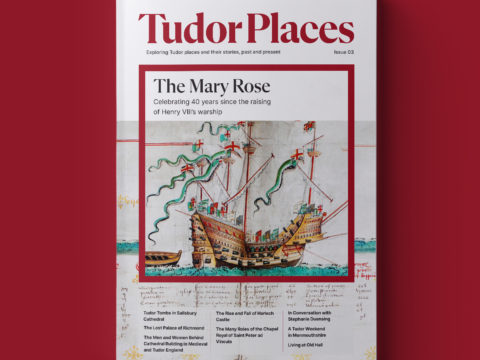Katharine of Aragon: Appearance & Character
Chapter 1: Appearance
So much has been written about Katharine and so many assumptions made in fiction (and, sometimes, in what purports to be non-fiction) that it is very hard to ignore everything and try to find enough contemporary evidence to give some insight into what she was like.
In particular, comparisons with her successor, Anne Boleyn, tend to put the women into opposing camps – if one was ‘good’ the other must have been ‘bad’. They are frequently presented as polar opposites – although we think a case can be made for them having certain characteristics in common – a willingness to challenge Henry VIII, a stubbornness that would have seen off any lesser woman in half the time, and a very high level of intelligence, although it manifested itself in different ways.
We have tried here to identify descriptions of Katharine that are contemporaneous, and to indicate what the bias of an individual commentator might have been – although that is fraught with difficulty, and presented as our tentative view, not a definitive truth.
Katharine’s first appearance to English eyes was when she was present at a meeting between her parents, and the English Ambassadors, in March 1489. The Ambassadors – Richard Nanfan and Thomas Savage – were being presented to Ferdinand and Isabella at Medina del Campo, where Katharine had been born. Their account of the visit dwells on the unbelievable splendour of Queen Isabella’s clothes and magnificent jewellery. Katharine herself, with her older sister, Maria, was in a small room, surrounded by their fourteen youthful maids-of-honour. Katharine, only three, was too young to dance, but Maria showed off the training that both were receiving in this important courtly skill.The following day, the children were present at a bull-fight, Isabella holding her youngest in her arms to watch the scene.
Katharine’s next recorded appearance on the public stage came some eight years later when, dressed in cloth-of-gold, she waited with her siblings to greet the Archduchess Marguerite of Austria, who had come from Burgundy, in exchange for Katharine’s own sister, Juana. Marguerite was to marry Juan, the heir to the Spanish thrones.
In the strict hierarchy so important to the Spanish court, Katharine was positioned lower on the staircase than her sisters, but above her father’s illegitimate daughter (who Ferdinand was offering to James IV of Scotland as a potential bride). Katharine’s biographer, Giles Tremlett, suggests that the paintings by Juan de Flandres of the Spanish Infantas may date from this period. The pictures are not definitively named, but this one might be Katharine.
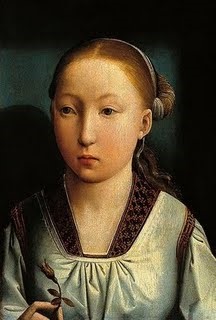
The death of Juan within a year of marrying the exotic French-educated archduchess, blamed on over-exertion in the marital bed, must have shocked Katharine profoundly, and perhaps influenced her marriage to Arthur. Further misery was heaped on the family when Marguerite had a miscarriage.
In 1501, it was Katharine’s turn to travel to a foreign land, to an unknown husband. On arriving in London, she processed riding a richly-harnessed mule, to St Paul’s Cathedral for her wedding. Her dress and appearance are not described in detail, other than to note that she wore a hat like a cardinal’s (that is, broad-brimmed, with a low crown), and that beneath this, her hair flowed over her shoulders. Sir Thomas More (who was present) was later to say that few women could compare for looks with Katharine in her youth, but frustratingly, there is no specific description.
It has long been affirmed that, contrary to the usual dark complexion of Spaniards, Katharine was fair – hardly surprising that she might not conform to the looks of many Spaniards when, like most royalty, her heritage was rather more multi-national.
As evidence for this, there is only one certain portrait – that of Lucas Horenbout. This dates to the mid-1520s. The Juan de Flandres painting is not definitively of Katharine, and the picture long accepted as Katharine in youth by Michel Sittow, is now named as probably her sister-in-law, Mary, daughter of Henry VII, later Queen of France.
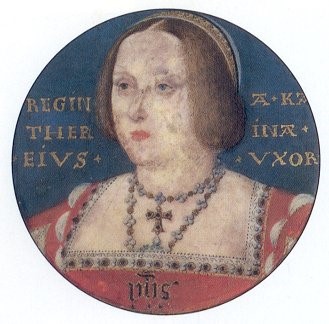
All of the other pictures that are named as representing Katharine show her with the gable hood which covered the hair.
The Queen’s hair seems to have been the aspect of her appearance that was most admired. Hall’s Chronicle, recalling the coronation of the royal couple, describes it as ‘of a very great length…beautiful and goodly to behold.’
Just after her marriage to Henry in 1509, Katharine was described, perhaps somewhat partially, by her Confessor, Fray Diego:
‘Her highness is very healthy and the most beautiful creature in the world, with the greatest gaiety and contentment that ever was.’
In 1512, Henry is recorded as kissing and caressing her in public, and, according to a Spanish source, he would invite guests to admire his beautiful wife.
Perhaps a rather less partial view was taken by a Venetian visitor to the court in 1515. She was by then 30 years old and is described, rather unchivalrously, and not, presumably, by anyone expecting to have his correspondence read, other than by the recipient, as ‘ugly and deformed.’
This seems a harsh judgement, as the next description, from 1519, by another Venetian, Sebastian Giustinian, records that Katharine was:
‘35 years old, and not handsome, though she ha[s] a very beautiful complexion. She [is] religious, and as virtuous as words could express.’
We have a brief glimpse of Katharine’s clothes, if not her looks, in 1520, when her nephew, the Emperor Charles V, paid a state visit to England, accompanied by Germaine de Foix, Katharine’s step-mother, the widowed Queen of Aragon (reputed, shockingly, to be the mistress of Charles, her step-grandson).
‘The Queen's petticoat was of silver lama [lamé?], and the gown of cloth of gold lined with violet velvet, with raised pile, on which the roses of England were wrought in gold. She wore a necklace of very large pearls, from which hung a very valuable diamond cross. Her head gear was of black velvet striped with gold lama, and powdered with jewels and pearls.’
Other fabulous gowns were in Katharine’s wardrobe – gold tissue, black tilsent (a type of shot silk) decorated with katherine-wheels and cloth of silver. She was certainly a match for Henry in a taste for magnificence and display – hardly the dowdy frump of legend!
Despite this impressive appearance, a year later, following the Field of the Cloth of Gold, King François informed the Venetian embassy that the King of England was ‘young and handsome’ but that his wife was ‘old and deformed’. Of course, Francois was no more inclined to like a Spaniard, than Katharine was to appreciate a French king.
From François’ cruel words, we can perhaps infer that the pretty girl that Katharine once was had lost her looks in the battle to survive seven pregnancies, and the grief of losing all her children but one.
The companion portraits of Henry and Katharine at Lambeth Palace date from around this time.
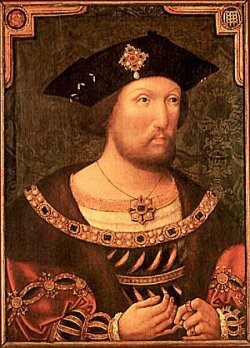
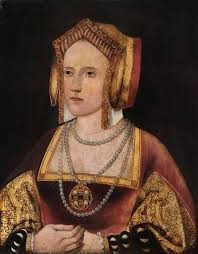
The last description of Katharine’s appearance dates from 1531, after she had been sent to The More, but was still treated as Queen and allowed to receive foreign visitors. Yet a third Venetian wrote, rather more chivalrously:
‘Her Majesty is not of tall stature, rather small. If not handsome, she is not ugly: she is somewhat stout and has always a smile on her face.’
The latter comment is surprising, as, by that time, Katharine had little to smile about!
